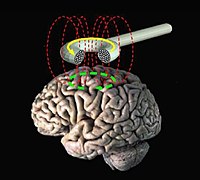
Photo from wikipedia
Due to its ability to improve the most frequent clinical sequelae left by ischemia, repetitive transcranial magnetic stimulation has been considered a promising therapeutic strategy for stroke. Those improvements are… Click to show full abstract
Due to its ability to improve the most frequent clinical sequelae left by ischemia, repetitive transcranial magnetic stimulation has been considered a promising therapeutic strategy for stroke. Those improvements are associated with changes in neurons and their synaptic liaisons. However, the hypothesis that this technique modulates astrocytes, potentiating their neuroprotective capabilities, was also raised. This study aims to identify the effects triggered by high‐frequency repetitive magnetic stimulation (HF‐rMS) on astrocytes that contribute to its neuroprotective effects. Neuron–glia and astrocyte cortical cultures subject to oxygen and glucose deprivation were used as an in vitro model of ischemia. Neuroprotection promoted by HF‐rMS was evaluated by analysis of markers of neuronal activity and morphometric analysis of neurons. Glial reactivity was determined by immunocytochemistry. The levels of growth factors in the astrocyte‐conditioned medium (CM) were assessed through a Growth Factor Array and glial‐derived neurotrophic factor (GDNF) expression was analyzed by RT‐PCR and Western blot. Our results show that neurons injured by ischemia can be rescued through the modulation of astrocytes by HF‐rMS. This modulation helps to maintain the number and length of neurites and increases the number of neurons expressing ERK1/2 and c‐Fos. Analysis of the astrocyte‐CM showed that HF‐rMS stimulated the release of several trophic factors by astrocytes. Moreover, GDNF was one of the released factors that contributed to the recovery mechanisms triggered by HF‐rMS. Our results show that modulation of astrocytes by HF‐rMS effectively rescues neurons injured by ischemia and suggest that by targeting astrocytes this approach can also be used to promote neuroprotection in other brain lesions.
Journal Title: Journal of Neurochemistry
Year Published: 2022
Link to full text (if available)
Share on Social Media: Sign Up to like & get
recommendations!